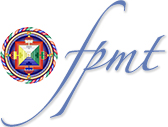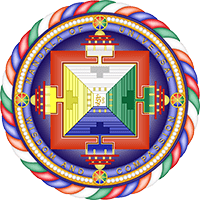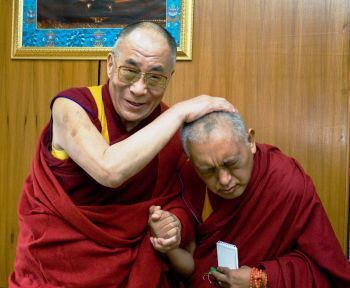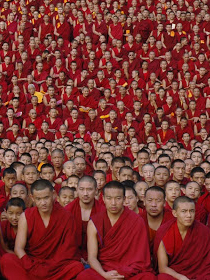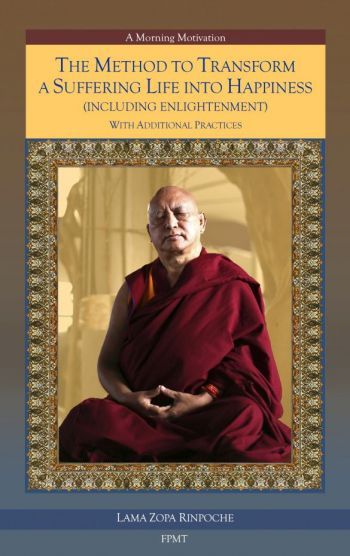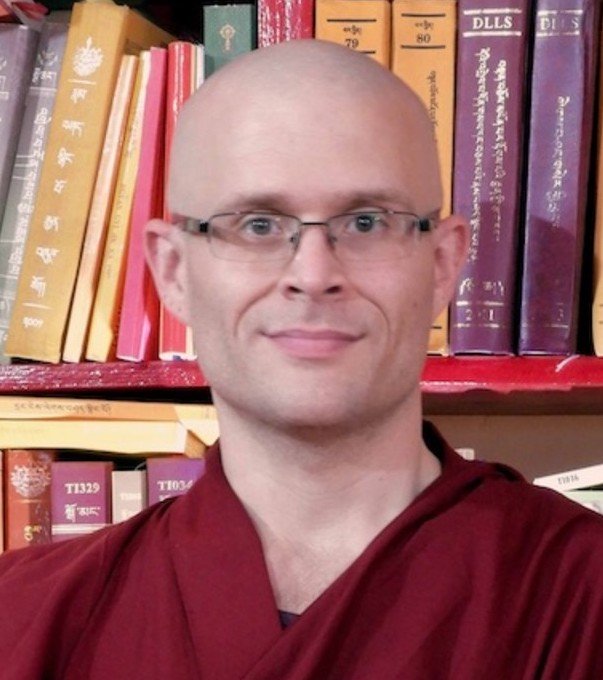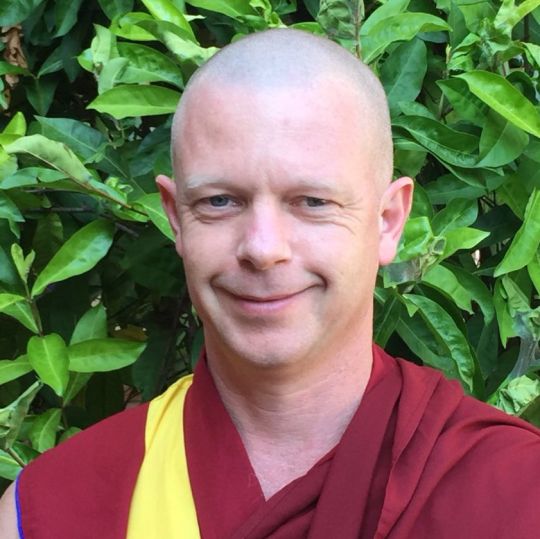- Home
- FPMT Homepage
Foundation for the Preservation of the Mahayana Tradition
The FPMT is an organization devoted to preserving and spreading Mahayana Buddhism worldwide by creating opportunities to listen, reflect, meditate, practice and actualize the unmistaken teachings of the Buddha and based on that experience spreading the Dharma to sentient beings. We provide integrated education through which people’s minds and hearts can be transformed into their highest potential for the benefit of others, inspired by an attitude of universal responsibility and service. We are committed to creating harmonious environments and helping all beings develop their full potential of infinite wisdom and compassion. Our organization is based on the Buddhist tradition of Lama Tsongkhapa of Tibet as taught to us by our founders Lama Thubten Yeshe and Lama Thubten Zopa Rinpoche.
- Willkommen
Die Stiftung zur Erhaltung der Mahayana Tradition (FPMT) ist eine Organisation, die sich weltweit für die Erhaltung und Verbreitung des Mahayana-Buddhismus einsetzt, indem sie Möglichkeiten schafft, den makellosen Lehren des Buddha zuzuhören, über sie zur reflektieren und zu meditieren und auf der Grundlage dieser Erfahrung das Dharma unter den Lebewesen zu verbreiten.
Wir bieten integrierte Schulungswege an, durch denen der Geist und das Herz der Menschen in ihr höchstes Potential verwandelt werden zum Wohl der anderen – inspiriert durch eine Haltung der universellen Verantwortung und dem Wunsch zu dienen. Wir haben uns verpflichtet, harmonische Umgebungen zu schaffen und allen Wesen zu helfen, ihr volles Potenzial unendlicher Weisheit und grenzenlosen Mitgefühls zu verwirklichen.
Unsere Organisation basiert auf der buddhistischen Tradition von Lama Tsongkhapa von Tibet, so wie sie uns von unseren Gründern Lama Thubten Yeshe und Lama Thubten Zopa Rinpoche gelehrt wird.
- Bienvenidos
La Fundación para la preservación de la tradición Mahayana (FPMT) es una organización que se dedica a preservar y difundir el budismo Mahayana en todo el mundo, creando oportunidades para escuchar, reflexionar, meditar, practicar y actualizar las enseñanzas inconfundibles de Buda y en base a esa experiencia difundir el Dharma a los seres.
Proporcionamos una educación integrada a través de la cual las mentes y los corazones de las personas se pueden transformar en su mayor potencial para el beneficio de los demás, inspirados por una actitud de responsabilidad y servicio universales. Estamos comprometidos a crear ambientes armoniosos y ayudar a todos los seres a desarrollar todo su potencial de infinita sabiduría y compasión.
Nuestra organización se basa en la tradición budista de Lama Tsongkhapa del Tíbet como nos lo enseñaron nuestros fundadores Lama Thubten Yeshe y Lama Zopa Rinpoche.
A continuación puede ver una lista de los centros y sus páginas web en su lengua preferida.
- Bienvenue
L’organisation de la FPMT a pour vocation la préservation et la diffusion du bouddhisme du mahayana dans le monde entier. Elle offre l’opportunité d’écouter, de réfléchir, de méditer, de pratiquer et de réaliser les enseignements excellents du Bouddha, pour ensuite transmettre le Dharma à tous les êtres. Nous proposons une formation intégrée grâce à laquelle le cœur et l’esprit de chacun peuvent accomplir leur potentiel le plus élevé pour le bien d’autrui, inspirés par le sens du service et une responsabilité universelle. Nous nous engageons à créer un environnement harmonieux et à aider tous les êtres à épanouir leur potentiel illimité de compassion et de sagesse. Notre organisation s’appuie sur la tradition guéloukpa de Lama Tsongkhapa du Tibet, telle qu’elle a été enseignée par nos fondateurs Lama Thoubtèn Yéshé et Lama Zopa Rinpoché.
Visitez le site de notre Editions Mahayana pour les traductions, conseils et nouvelles du Bureau international en français.
Voici une liste de centres et de leurs sites dans votre langue préférée
- Benvenuto
L’FPMT è un organizzazione il cui scopo è preservare e diffondere il Buddhismo Mahayana nel mondo, creando occasioni di ascolto, riflessione, meditazione e pratica dei perfetti insegnamenti del Buddha, al fine di attualizzare e diffondere il Dharma fra tutti gli esseri senzienti.
Offriamo un’educazione integrata, che può trasformare la mente e i cuori delle persone nel loro massimo potenziale, per il beneficio di tutti gli esseri, ispirati da un’attitudine di responsabilità universale e di servizio.
Il nostro obiettivo è quello di creare contesti armoniosi e aiutare tutti gli esseri a sviluppare in modo completo le proprie potenzialità di infinita saggezza e compassione.
La nostra organizzazione si basa sulla tradizione buddhista di Lama Tsongkhapa del Tibet, così come ci è stata insegnata dai nostri fondatori Lama Thubten Yeshe e Lama Zopa Rinpoche.
Di seguito potete trovare un elenco dei centri e dei loro siti nella lingua da voi prescelta.
- 欢迎 / 歡迎
简体中文
“护持大乘法脉基金会”( 英文简称:FPMT。全名:Foundation for the Preservation of the Mahayana Tradition) 是一个致力于护持和弘扬大乘佛法的国际佛教组织。我们提供听闻,思维,禅修,修行和实证佛陀无误教法的机会,以便让一切众生都能够享受佛法的指引和滋润。
我们全力创造和谐融洽的环境, 为人们提供解行并重的完整佛法教育,以便启发内在的环宇悲心及责任心,并开发内心所蕴藏的巨大潜能 — 无限的智慧与悲心 — 以便利益和服务一切有情。
FPMT的创办人是图腾耶喜喇嘛和喇嘛梭巴仁波切。我们所修习的是由两位上师所教导的,西藏喀巴大师的佛法传承。
繁體中文
護持大乘法脈基金會”( 英文簡稱:FPMT。全名:Found
ation for the Preservation of the Mahayana Tradition ) 是一個致力於護持和弘揚大乘佛法的國際佛教組織。我們提供聽聞, 思維,禪修,修行和實證佛陀無誤教法的機會,以便讓一切眾生都能 夠享受佛法的指引和滋潤。 我們全力創造和諧融洽的環境,
為人們提供解行並重的完整佛法教育,以便啟發內在的環宇悲心及責 任心,並開發內心所蘊藏的巨大潛能 — 無限的智慧與悲心 – – 以便利益和服務一切有情。 FPMT的創辦人是圖騰耶喜喇嘛和喇嘛梭巴仁波切。
我們所修習的是由兩位上師所教導的,西藏喀巴大師的佛法傳承。 察看道场信息:
- FPMT Homepage
- News/Media
-
- Study & Practice
-
-
- About FPMT Education Services
- Latest News
- Programs
- New to Buddhism?
- Buddhist Mind Science: Activating Your Potential
- Heart Advice for Death and Dying
- Discovering Buddhism
- Living in the Path
- Exploring Buddhism
- FPMT Basic Program
- FPMT Masters Program
- FPMT In-Depth Meditation Training
- Maitripa College
- Lotsawa Rinchen Zangpo Translator Program
- Universal Education for Compassion & Wisdom
- Online Learning Center
-
- Prayers & Practice Materials
- Overview of Prayers & Practices
- Full Catalogue of Prayers & Practice Materials
- Explore Popular Topics
- Benefiting Animals
- Chenrezig Resources
- Death & Dying Resources
- Lama Chopa (Guru Puja)
- Lama Zopa Rinpoche: Compendium of Precious Instructions
- Lama Zopa Rinpoche: Life Practice Advice
- Lama Zopa Rinpoche Practice Series
- Lamrim Resources
- Mantras
- Prayer Book Updates
- Purification Practices
- Sutras
- Thought Transformation (Lojong)
- Audio Materials
- Dharma Dates - Tibetan Calendar
- Translation Services
- Publishing Services
- Ways to Offer Support
- Prayers & Practice Materials
-
- Teachings and Advice
- Find Teachings and Advice
- Lama Zopa Rinpoche Advice Page
- Lama Zopa Rinpoche: Compendium of Precious Instructions
- Lama Zopa Rinpoche Video Teachings
- ༧སྐྱབས་རྗེ་བཟོད་པ་རིན་པོ་ཆེ་མཆོག་ནས་སྩལ་བའི་བཀའ་སློབ་བརྙན་འཕྲིན།
- Podcasts
- Lama Yeshe Wisdom Archive
- Buddhism FAQ
- Dharma for Young People
- Resources on Holy Objects
- Teachings and Advice
-
-
*If a menu item has a submenu clicking once will expand the menu clicking twice will open the page.
-
-
- Centers
-
- Teachers
-
- Projects
-
-
-
-
*If a menu item has a submenu clicking once will expand the menu clicking twice will open the page.
-
-
- FPMT
-
-
-
-
-
The mental pollution of misconceptions is far more dangerous than drugs. Wrong ideas and faulty practice get deeply rooted in your mind, build up during your life, and accompany your mind into the next one. That is much more dangerous than some physical substance.
Lama Thubten Yeshe
-
-
-
- Shop
-
-
-
The Foundation Store is FPMT’s online shop and features a vast selection of Buddhist study and practice materials written or recommended by our lineage gurus. These items include homestudy programs, prayers and practices in PDF or eBook format, materials for children, and other resources to support practitioners.
Items displayed in the shop are made available for Dharma practice and educational purposes, and never for the purpose of profiting from their sale. Please read FPMT Foundation Store Policy Regarding Dharma Items for more information.
-
-

Translating Buddhist Texts: Bringing the Sacred Dharma to the World
Current Translation Projects | English Translations | Resources for Readers | Translators
Thank you so much for your support!
As the Dharma takes root in the West, clear and accurate translations of Buddhist texts, prayers, and teachings are crucial. FPMT Translation Services oversees the translation, editing, publishing, and updating of English translations of sadhanas, prayers, rituals, sutras, commentaries on philosophy and tantra, and key texts for FPMT students and FPMT education programs. We work with translators around the world and collaborate with regional translation offices and groups to translate texts into Chinese, French, German, Spanish, and other languages.
Current Translation Projects
The FPMT Translation Fund supports the critical work of translating classic texts and sutras from the original Tibetan into English, French, Spanish, German, Italian, Portuguese, Chinese, Mongolian, and other languages. The translations support the FPMT Masters Program and FPMT Basic Program as well as providing essential practice materials that have been advised by Lama Zopa Rinpoche.
The Tibetan canon contains three different editions of the Sutra of Golden Light—a 21-chapter edition, a 29-chapter edition, and a 31-chapter edition. The sutra contains a variety of teachings and its recitation is a cause for global harmony and peace as well as a source of vast merit. Lama Zopa Rinpoche has made a personal vow to preserve and propagate this sutra and it is his vision to translate all three versions of the sutra from Tibetan, making them available in as many languages as possible.
At Rinpoche’s behest, the 21-chapter edition of the Sutra of Golden Light was translated into English in 2005 by Losang Dawa and subsequently translated into many other languages. Work is currently underway to translate the 29-chapter and 31-chapter edition, as well as to review the translation of the 21-chapter edition.
As the translation of the 29 and 31-chapter edition has been personally requested by Rinpoche, the completion of this project is a priority for the FPMT Education Services—we need your support!
Help support this project:
- 21 & 29 Chapter Version | Help sponsor this translation – USD 19,166
- 31 Chapter Version | Help sponsor this translation – USD 11,500
We are current working on the translation and translation review of these texts:
- The Extensive Four Mandala Offering to Chittamani Tara
- The Abbreviated Four Mandala Offering to Chittamani Tara
- Chittamani Tara Sadhana
- Chittamani Tara Self-Initiation
Help sponsor this project: $13,500
A projected initiated by Lama Zopa Rinpoche. This is a compilation of commentaries given by Gyurme Khensur Rinpoche Lobsang Jampa over years on the Six Yogas of Naropa, compiled Lorne Ladner.
Help sponsor this project: $6,000
In 1975, Trijang Rinpoche gave an extensive and very detailed commentary on the Chakrasamvara body mandala practice at the Library of Tibetan Works and Archives, Dharamsala. The Tibetan transcript of this teaching was thoroughly edited by a team of scholars at the request of Lama Zopa Rinpoche and was released in 2021. Also, at Rinpoche’s request, we are now working on translating this precious commentary into English.
Help sponsor this project: $70,000
A Guidebook to the Supreme Sacred Place of Clear and Cool Mountain
Sunlight That Causes the Lotus of Faith to Blossom: A Guidebook to the Supreme Sacred Place of Clear and Cool Mountain composed by Vajradhara Changkya Rolpai Dorje—an important Gelug lineage holder and guru of the Qianlong Emperor—and his followers.
Wutaishan, or Five-Peaked Mountain, is a mountain sacred to Manjushri that has long been one of the most important pilgrimage sites for Tibetan, Chinese, and Mongolian Buddhists. This text is the most renowned and historically important Tibetan guidebooks to the area. While having long been the foremost pilgrimage guide for Tibetan travelers, detailing the most important sacred sites on the mountain and the stories of masters who lived and visited the place, the text has never before been translated into English.
Help sponsor this project: US$12,000.
This elucidation of Śāntideva’s Bodhicaryāvatāra was written by Dragpa Gyaltsen (1762–1835), an abbot of the great Gelug monastery of Labrang Tashikhyil. Based largely on Gyaltsab’s commentary, Dragpa Gyaltsen’s composition is peppered with gems of elucidations from great Indian masters such as Nāgārjuna and Candrakīrti as well as renowned Tibetan scholars such as Tsongkhapa and Kachen Yeshe Gyaltsen. For those who are serious about studying and practicing the bodhisattva’s way of life, its harmonious amalgamation of informative rigor and practical sensibilities provides a clear inspiring guide on how to traverse the entire path to enlightenment.
Help sponsor this project: US$27,000.
This is a commentary to the Ornament for Clear Realization (Abhisamayalamkara) by Gyaltsab Darma Rinchen, including Maitreya’s Ornament for Clear Realization and Haribhadra’s Commentary: Clear Meaning. The draft translation is currently being prepared for publication.
Translator: Toh Sze Gee
Help sponsor this project: US$6,000.
“The gift of Dharma surpasses all gifts” – Dhammapada (Verse 354)
We welcome you to sponsor the translation of these precious texts. If you would like to sponsor the translation of a text in its entirety, please contact François Lecointre directly. If you would like to make a general donation of any amount toward our translation projects, please click on the donate button below. If you would like to direct your donation to a specific translation project, please indicate the project name in the comments field. Thank you!
English Translations
In order to help preserve the integrity and accuracy of the Gelug textual tradition in English, FPMT Translation Services aims to release high-quality translations that are accessible to practitioners and produced with scholarly rigor.
In 2011, FPMT hosted its first international translation conference, Taking Up the Challenge of Translating Buddhism, at Istituto Lama Tzong Khapa in Italy. Following the conference, the FPMT Translation Services team—together with the Lotsawa Rinchen Zangpo Translation Team (LRZTT) composed of FPMT-affiliated translators and the FPMT Translation and Editorial Board (TEB)—began the long-term project of compiling a Tibetan-English glossary for the organization. The purpose of this ongoing project is to create consistency throughout FPMT translations.
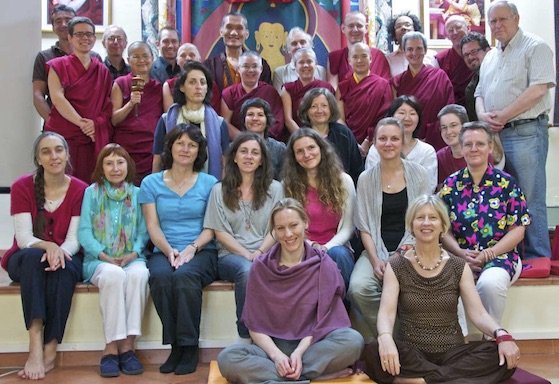
Taking up The Challenge of Translating Buddhism conference participants at Lama Tzong Khapa Institute in 2011.
We constantly strive to improve the quality of our translations. FPMT Translation Services employs a multi-stage editorial process for all of our texts that includes not only content and copy editing, but also a review by a second translator. Over the recent years, we have further improved the consistency of our translations through the compilation and use of databases for common stanzas, mantras, and deity names. Also, we now transliterate all Sanskrit terms in our texts in order to aid readers in correct Sanskrit pronunciation as well as preserve the accuracy and efficacy of mantras.
Resources for Readers
- A Guide to Sanskrit Transliteration and Pronunciation
This document gives a brief introduction to the transliteration of Sanskrit found in FPMT translations.
Translators
Our translators live in every part of the world and bring extensive Dharma and language knowledge to their work as translators.
Some of our English Language translators:
Joona has a PhD from the School of Oriental and African Studies (SOAS) and has held postdoctoral teaching and research positions with a focus on Tibetan art and/or religious history at the Philadelphia Museum of Art, Heidelberg University, and the University of Helsinki, and has completed a visiting lectureship at Rangjung Yeshe Institute. His published research includes studies of Gelug history, particularly on Phabongkha Dechen Nyingpo, and work on Tibetan Buddhist painting and architecture.
Toh Sze Gee holds a BSc with honors in mathematics as well as a postgraduate diploma in education. After teaching in a junior college in Singapore for several years, she joined the first, seven-year residential FPMT Masters Program (MP) at Istituto Lama Tzong Khapa (ILTK) in 1998. She graduated with high honors; since then she has been teaching regular Dharma courses in Singapore and translating texts from Tibetan into English for the FPMT Basic Program (BP) and the FPMT Masters Program (MP).
Sze Gee was well known among her fellow MP students for her incredible energy both for study and Dharma practice. True to form, she accepted and served not only as teaching assistant for Ornament for Clear Realization during ILTK’s second FPMT Masters Program but also as an Tibetan-English interpreter. During that time, she completed translating Gyaltsab Je’s commentary to Ornament, including the Haribhadra commentary and Maitreya’s root verses. She is currently working on finalizing the translation in preparation for publication. She also completed the translation of Chokyi Gyaltsen’s General Meaning of the Middle Way, another important MP text.
Sze Gee has served as interpreter for Geshe Ngawang Drakpa at FPMT’s Tse Chen Ling in California. She since has been teaching assistant for Nalanda Monastery’s first MP and supported Istituto Lama Tzong Khapa’s third MP as teaching assistant by video from Singapore. She currently is teaching assistant for ILTK’s fourth MP, offering her expertise for the subject of Ornament.
Gavin Kilty spent over a decade in Dharamsala, India, studying the Gelug monastic curriculum at the Institute of Buddhist Dialectics and becoming proficient in Tibetan. After returning to the UK, he trained and worked as an English-language teacher, and since the late ’90s, he has worked as a Tibetan-English translator. He is also a teacher of Tibetan language and has taught courses for the FPMT’s Lotsawa Rinchen Zangpo Translator Program in Dharamsala, Istituto Lama Tzong Khapa in Italy, and Jamyang Buddhist Centre in London.
Gavin is a full-time translator for the Institute of Tibetan Classics. His completed works include Ornament of Stainless Light: An Exposition of the Kālacakra Tantra; Mirror of Beryl: A Historical Introduction to Tibetan Medicine; Tsongkhapa’s A Lamp to Illuminate the Five Stages: Teachings on Guhyasamāja Tantra; and Tales from the Tibetan Operas: The Eight Great Folk Operas of Tibet. His other translations include The Splendor of an Autumn Moon: The Devotional Verse of Tsongkhapa; The Life of My Teacher: A Biography of Ling Rinpoché by His Holiness the Dalai Lama; and Understanding the Case Against Shukden by the International Gelugpa Foundation.
Gavin is a translation reviewer for 84000: Translating the Words of the Buddha, and as a member of the FPMT Lotsawa Rinchen Zangpo Translation Team, he participated in the discussions that formed the basis for the compilation of FPMT’s glossary of preferred terms.
Gavin contributes to the FPMT Basic Program (BP) as a visiting teacher and translated “The Tathāgata Essence,” the first chapter of the standard BP commentary on the Uttaratantra by Gyaltsab Je. He is currently working on a translation of the Daśacakra Kṣitigarbha Sutra for FPMT Education Services.
Ven. Lekden started leading Buddhist communities while an undergraduate and has studied, served, and taught at various Dharma centers since then. In 2012, he joined Sera Je Monastic University in southern India where he continues to practice and study in the geshe program.
Ven. Lekden is an FPMT registered teacher and has given talks and meditation instruction in India and the United States. He has translated a number of sadhanas, prayers, and other texts for FPMT.
Geshe Namdak has interpreted from Tibetan into English for over a decade at various teaching events, is an interpreter for the annual ordination rituals with His Holiness in Dharamsala, and was a founding teacher of Sera Je’s Translators Program and member of Sera Je’s Education Department for six years. Currently, he teaches at Jamyang Buddhist Centre in London and at other centers in Europe and in India. He translated a cycle of texts related with Chenrezig Gyalwa Gyatso and various prayers and practices for FPMT Education Services and is working on several translation projects, including Khedrub Je’s Clearing Mental Darkness: An Ornament of Dharmakīrti’s “Seven Treatises on Valid Cognition”; Vinaya material; and practices related with Guhyasamāja.
Philip has translated three short booklets on vegetarianism by Geshe Thubten Soepa as well as texts by the 19th-century Mongolian scholar Agvaanbaldan. In cooperation with Conni Krause, he translated Je Tsongkhapa’s Middle Length Lamrim from Tibetan into English for the FPMT Basic Program. This work has recently been published by Wisdom Publications.
Other Language Translations and Translators:
- Les traductions en français
- Las traducciónes en español
Connie has translated Je Tsongkhapa’s Middle Length Lamrim from the original Tibetan into German and has helped to make available Discovering Buddhism and FPMT Basic Program texts as well as the FPMT Essential Buddhist Prayers books in German.
He has translated the Commentary to “Engaging in the Bodhisattva Deeds” (spyod ’jug tikka) by Gyaltsab Je, a supplementary text for the BP subject of Bodhisattva Deeds, and Losang Chokyi Gyaltsen’s Wisdom Debating Ignorance (gshaga ‘debs), from Tibetan into English. For the FPMT Basic Program in Munich, Ven. Fedor has translated various BP texts into German.
Visit our Distributing FPMT Education Materials page for information about our distributing, licensing and copyright guidelines.
- Home
- News/Media
- Study & Practice
- About FPMT Education Services
- Latest News
- Programs
- New to Buddhism?
- Buddhist Mind Science: Activating Your Potential
- Heart Advice for Death and Dying
- Discovering Buddhism
- Living in the Path
- Exploring Buddhism
- FPMT Basic Program
- FPMT Masters Program
- FPMT In-Depth Meditation Training
- Maitripa College
- Lotsawa Rinchen Zangpo Translator Program
- Universal Education for Compassion & Wisdom
- Online Learning Center
- Prayers & Practice Materials
- Overview of Prayers & Practices
- Full Catalogue of Prayers & Practice Materials
- Explore Popular Topics
- Benefiting Animals
- Chenrezig Resources
- Death & Dying Resources
- Lama Chopa (Guru Puja)
- Lama Zopa Rinpoche: Compendium of Precious Instructions
- Lama Zopa Rinpoche: Life Practice Advice
- Lama Zopa Rinpoche Practice Series
- Lamrim Resources
- Mantras
- Prayer Book Updates
- Purification Practices
- Sutras
- Thought Transformation (Lojong)
- Audio Materials
- Dharma Dates – Tibetan Calendar
- Translation Services
- Publishing Services
- Teachings and Advice
- Find Teachings and Advice
- Lama Zopa Rinpoche Advice Page
- Lama Zopa Rinpoche: Compendium of Precious Instructions
- Lama Zopa Rinpoche Video Teachings
- ༧སྐྱབས་རྗེ་བཟོད་པ་རིན་པོ་ཆེ་མཆོག་ནས་སྩལ་བའི་བཀའ་སློབ་བརྙན་འཕྲིན།
- Podcasts
- Lama Yeshe Wisdom Archive
- Buddhism FAQ
- Dharma for Young People
- Resources on Holy Objects
- Ways to Offer Support
- Centers
- Teachers
- Projects
- Charitable Projects
- Make a Donation
- Applying for Grants
- News about Projects
- Other Projects within FPMT
- Support International Office
- Projects Photo Galleries
- Give Where Most Needed
- FPMT
- Shop
Translate*
*powered by Google TranslateTranslation of pages on fpmt.org is performed by Google Translate, a third party service which FPMT has no control over. The service provides automated computer translations that are only an approximation of the websites' original content. The translations should not be considered exact and only used as a rough guide.Cherishing others opens the door to every happiness for self and others.
